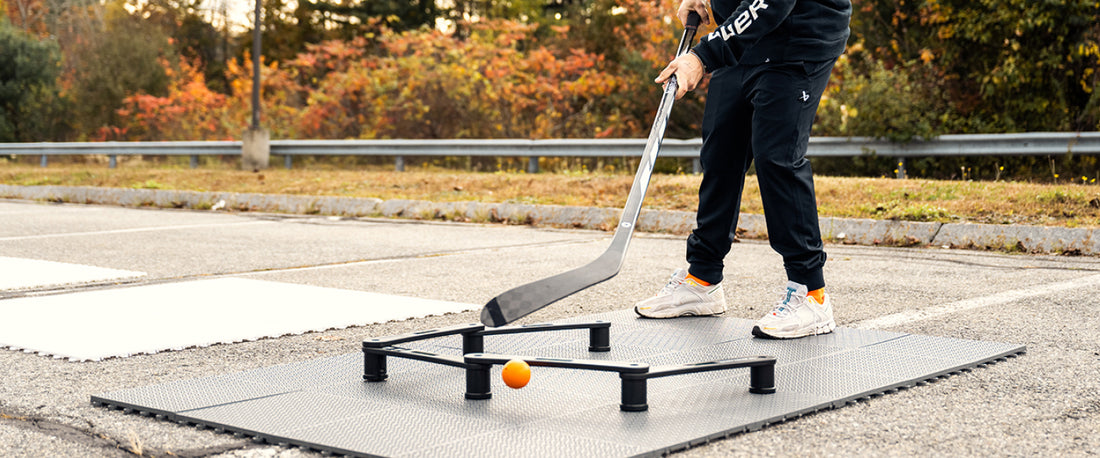How to Train and Improve Hockey Skills Off the Ice
Nowadays, ice time is at a premium and many young players may only have one practice session per week. Most of this time is spent working on team tactics and little time is spent on individual skills. Luckily, there’s a lot that players can do off the ice to enhance their stickhandling and skills on the ice. Hockey players who want to gain an edge will benefit from adding off-ice training to their game. In this post, we’ll cover the whens, the hows and the whys of off-ice hockey training.
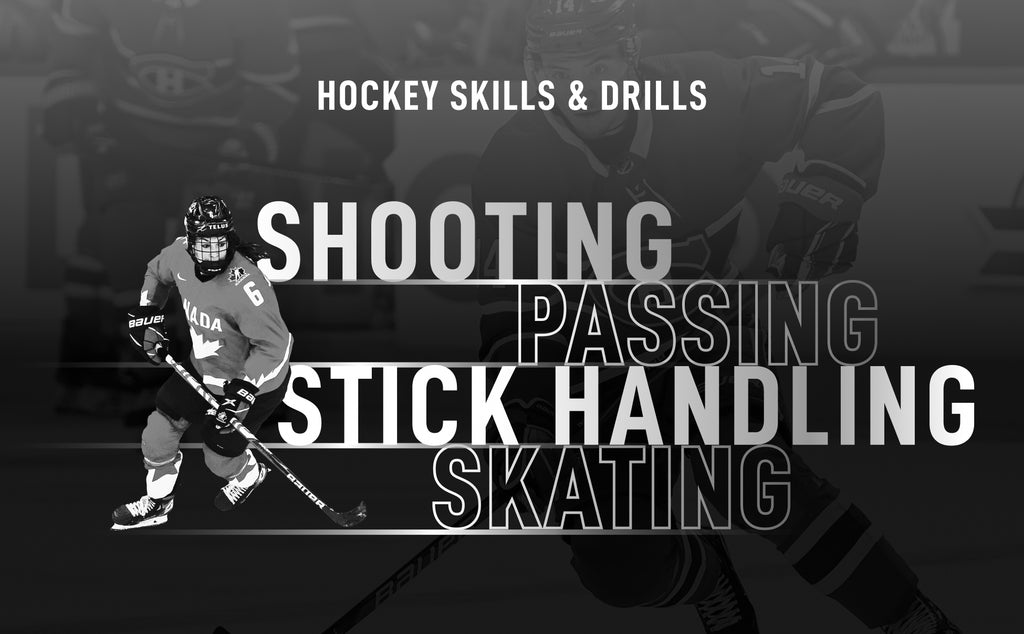
Part of what makes hockey fun to play (and fun to watch) is its dynamic nature. Behind the excitement, there’s a lot of different skills at work. There are four key types of skills at play: Shooting, Passing, Stickhandling, and Skating.
Players who want to advance will want to focus on each of these key skills. The more a player can do at home to enhance their game will allow them to progress quickly and ultimately perform at a higher level.
Read on to discover how to do it.
We were lucky having my brothers who all loved hockey and wanted to be on the ice competing together. It definitely helped us become the players we are today.
-- The Hughes brothers
When (and How) to Train
Weekly hockey practice will help to develop teamwork, but aspiring hockey players will want to invest extra time to develop their skills. Cross Training - where players engage in different sports in order to improve performance in their main sport - can be helpful too. But the most effective training strategy will develop the core skills needed to play well.
For players who want to get after it, the year will bring a different training strategy depending on the season. Here’s what generally happens - including what players can do to gain an edge.

- Training Camp: Just before regular season is training camp. This is where skating intensifies and battle drills are practiced.
- Regular Season: For players who live and breathe hockey, just six months - from October to March - is spent in the regular season. This is when practices and games happen. Players can improve during this time by watching videos and working with their coaches to improve their weaknesses.
- Playoffs and Recovery: In April, playoffs happen. This is when players can expect to invest their energy in games and body in recovery when off the ice. In May, playoffs may continue. Players who want to improve will want to have a solid rest period during this time so they’re ready for off-season training when summer starts.
- Off-Season Training: From June through August, players can expect to practice focused skill work and skating work to build endurance. This is also when intensified skating and scrimmages are practiced in prep for training camp and the season.
For players looking to seriously improve their skills, off-season is the best time to invest more time in training. This time of year presents a great opportunity for players to work on the skills that will take their games to the next level. It’s also a great time of year for players to get away from the pressures of the team and work on their skills at their own level.
Benefits of Training
Spending more time training is the secret sauce for becoming a better player and the benefits are both physical and mental. Skill development and gaining a competitive edge are the main reasons to train, but there are loads of other benefits that come with regular training. Like team bonding, physical conditioning, injury prevention, and even mental preparation for games.
Hockey Training Drills & Exercises
Most of our off-ice training in the summer was in the driveway, having fun and trying to beat each other in any game we came up with. Target shooting, stick handling, shooting for posts.
-- The Hughes brothers
The game of hockey isn’t predictable, but using tools to improve a player’s reactionary instincts will provide a huge benefit.
Here’s how players can improve their Shooting, Passing, Stickhandling, and Skating skills. We’ve also included some links to YouTube videos to inspire players to get creative with their drills.
Stickhandling
Stickhandling is an important skill in hockey that allows players to maintain possession, evade defenders, create scoring opportunities, and control the flow of the game. Here are some drills to help players improve their stickhandling.
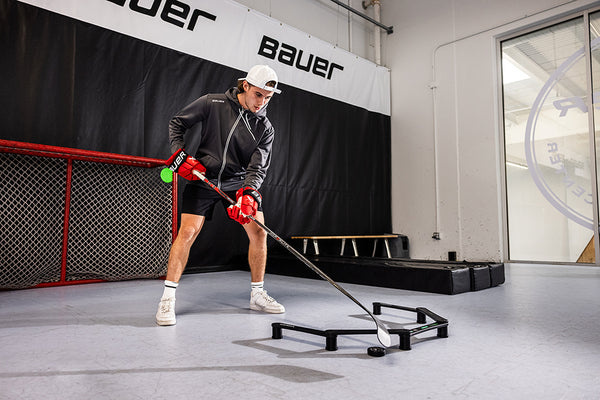
For Practicing Custom Stick Handling Drills and Puck Control Moves: Try the Digital Reactor Dangler
Players know that puck control is everything. And players looking to improve their puck control moves will want to focus on agility, quickness, acceleration and lateral movement with a stickhandling trainer. The Digital Reactor Dangler helps them do just that! Practicing with the Digital Reactor Dangler will make hands quicker with custom stick handling drills. The object of the game is to get as many puck moves as possible in 45 seconds. Players can compete against themselves or other players with these drills for at least 15 minutes every day. The best part is that the Dangler offers a new game every time a player uses it.

To Take Off-Ice Training to the Next Level: Try Multisport Tiles
Three different surfaces meet a variety of needs and can be used with roller hockey skates or sneakers. These Multisport Tiles can be assembled outdoors, in the garage or basement, or any other convenient spot. Our dryland hockey tiles can be used with the Danglers and Passers to simulate the feeling of the ice. These tiles can be used to practice in a variety of ways. The sky is the limit!
Passing
Good passing is important to the success of a hockey team, as it contributes to both offensive and defensive strategies, fosters teamwork, and creates scoring opportunities. Here are some drills for players looking to improve their passing.
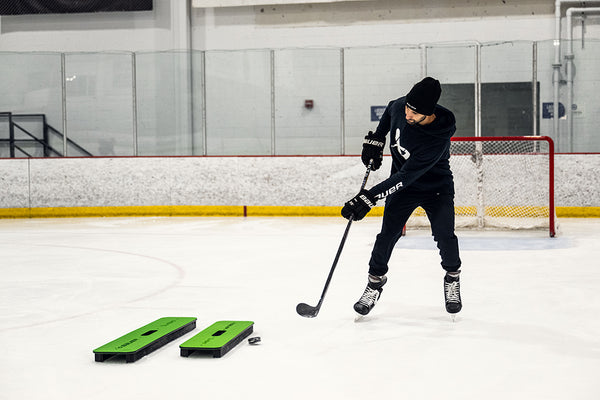
For Passing, One-Timers and Rebounds: Try the Reactor Slingshot Passer
Ice hockey passers can help players practice passing without a coach. The Reactor Slingshot Passer is made with heavy duty rubber bumpers to allow players to practice passing, receiving and rebounding from anywhere on the ice. A hidden channel allows players to pass the puck through the middle, making it easy to practice shooting and passing drills. To improve passing accuracy, players can stand a short distance away from the rebounder and pass the puck against it, aiming for different areas to practice accuracy.
TIP: For an extra challenge, change up the speed, angle, and intensity of the drills to simulate real-game scenarios.

To Quicken Wrists and Sharpen Passing and Reception Skills: Reactor Clamp-On Passer
The Reactor Clamp-On Passer helps players quicken their wrists from their driveway, basement or garage. This hockey passer easily attaches to Multi-Sport tiles with a handy two clamp system to help players practice without a buddy.
Shooting
Players with a strong shot can force the opposing goaltender to make saves, leading to rebounds and second-chance scoring opportunities for teammates. Here are some drills for hockey players looking to improve their shooting skills.
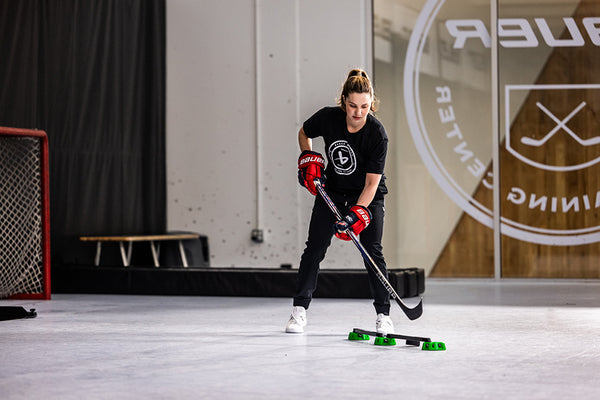
For Puck Control and Stick Handling: Try the Reactor Dangler
Players can’t score if they can’t shoot. Back in the day, coaches used to send kids home with instructions to shoot 100 pucks per day. But these types of shots aren’t always realistic. For players to progress, it helps to add movement to their shots to simulate shooting in a game scenario. The Reactor Dangler helps players practice how to get their shots off quickly while they’re moving. Players can practice the Deke and Finish drill to simulate game scenarios where they need to beat defenders before attempting to score. Here’s how: players can set up a shooting target or net and practice deking around the dangler before taking a shot on goal. When players practice the Deke and Finish and these drills consistently, goalies won’t know what hit them!
Skating
Skating is a foundational skill in hockey that directly impacts a player’s ability to contribute offensively, defensively, and in transition. Here are some drills for players looking to improve their skating.
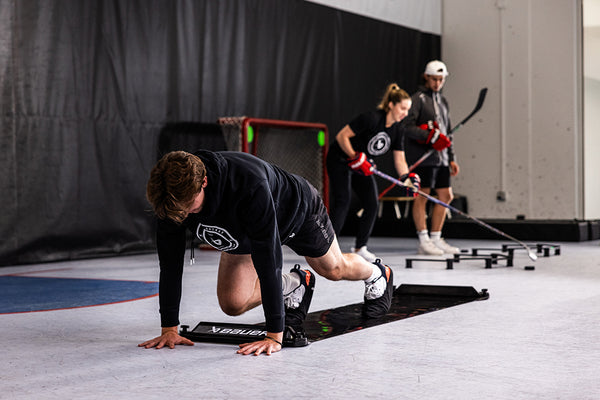
To Build Muscle and Work on Skating Endurance Off the Ice: Try the Reactor Slide Board
Skating is one of the key skills in hockey and improving skating endurance can help players become stronger at the game. But with limited time on the ice each week, how do players become better at skating? Cross Training with other activities like running and cycling can help to increase overall endurance, but practicing skating moves will help players become better skaters.
The Reactor Slide Board is one of the best tools to practice early in the off-season to keep those muscles strong while increasing power, speed and agility on the ice. Plus, players can use it in lots of different ways. Lateral slides help to work on lateral mobility, while push ups on the board strengthen the core, arms and stabilizer muscles. By using the board to train, players can:
- build skating endurance and engage all of the muscles involved in skating
- improve lateral power and agility
- combine skating and puck handling moves
- build muscle in the legs, back, abdominals and arms
- improve mobility and increase range of motion in every skating stride
- increase on-ice speed and power
The Reactor Slide Board is fully adjustable and comes with three sizes of booties to accommodate different sized players and grow with young players.
Finally…How Often to Train?

All the stuff we did on the driveway was FUN and definitely helped us when we got into more serious on-ice training.
-- The Hughes brothers
The Hughes brothers know that when training is fun, it’s easier to work hard. And when it’s easier to work hard, it’s easier to progress naturally and improve skills. Everyone is busy, but the more a player can do at home, the easier it will be to progress and elevate their hockey game. The answer is, players should aim to train as often as time permits - and the training is fun. Ultimately, the right amount of training each week depends on the player (and their passion for the game).
Each of these hockey stickhandling tools have limitless opportunities. They’re each designed to improve a different skill, from stickhandling to passing to skating to shooting. Above all, these products inspire creativity to do something different. With these products, training will never be boring.
